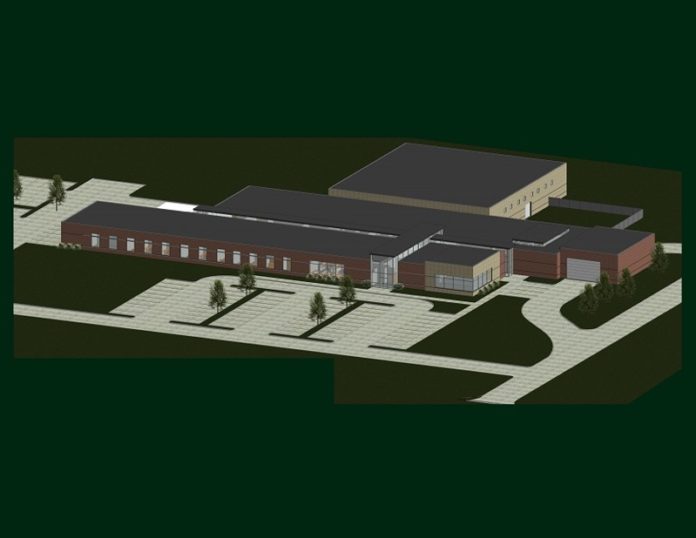
The Dallas County Board of Supervisors approved Tuesday a fourth try for voter approval of a new Law Enforcement Center. County voters have rejected three previous bond referendums aimed at financing the new facility, projected to cost more than $20 million.
With the supervisors approval of the project now secured, a political action committee called Citizens for Dallas County aims to set to work persuading voters to approve the law enforcement center’s financing in turn.
The supervisors gave the nod to a proposed design presented Tuesday by the Waukee-based Design Alliance and the Samuels Group, a Des Moines-based consulting firm.
The cost of the new Ortonville jail and sheriff’s administration facility is estimated at $21.3 million, with an optional lagoon expansion and geothermal heating system possibly adding an additional $600,000 each.
The footprint of the latest design is 56,679 square feet and is “believed to be more cost effective and simplifies the look for public members who thought the previous building was ‘too nice,'” according to Jerry Purdy of Design Alliance, the county’s architectural adviser.
“The good news for the plan is the simplicity to adjust layout as needed and the constructability for cost control,” Purdy told the supervisors Tuesday. He said the new design moved from a sloped roof to a more commercial roof solution, not a flat roof but a “near-level roof,” with a pitch ratio of 4:12 or 4:15.
Dallas County’s rapid growth makes a new law enforcement center seem inevitable. The population of the county is now about 80,000 and has basically tripled since 1990. Population projections by the U.S. Census Bureau predict the number will double again in the next 25 years, rising to almost 160,000 people by 2040.
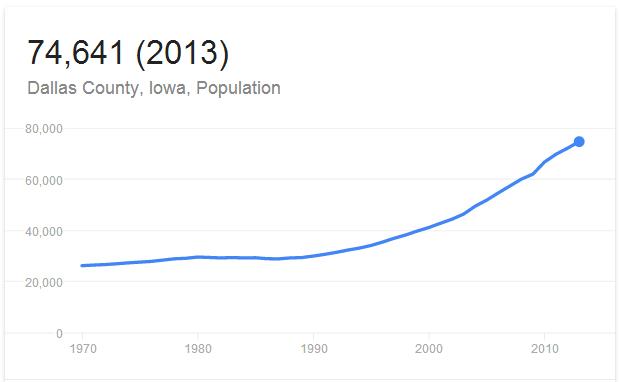
The current jail at 901 Nile Kinnick Drive N. was built in 1988, when the county’s population was 30,000. It is licensed for 32 beds but will reduce to 24 beds in March 2018, when a waiver expires from the Iowa Department of Corrections. According to the supervisors, the question is not whether to build a new jail but when to build it, and the longer voters postpone the inevitable, the higher the cost of eventual construction.
The supervisors cannot actively campaign in favor of a yes vote. State law limits their activities to educating and informing their constituents. This is where Citizens for Dallas County intends to step in and encourage voters to pass the measure and build the new jail.
Three representatives of Citizens for Dallas County attended the Aug. 31 board of supervisors meeting and outlined their plan for a vote-yes campaign. Mark Powell of Dallas Center, Mary Earnhardt of West Des Moines and Kellie Paschke of Waukee said the committee plans to take about six months to educate county voters about the need for a new law enforcement center.

In an early-August briefing to the board, the Samuels Group crunched the numbers and offered the supervisors — and voters — a new way to look at the jail question. Sid Samuels, president of the Samuels Group, concluded that by the year 2020, the cost to Dallas County taxpayers to export their prisoners to other counties will exceed the cost of building a new jail.
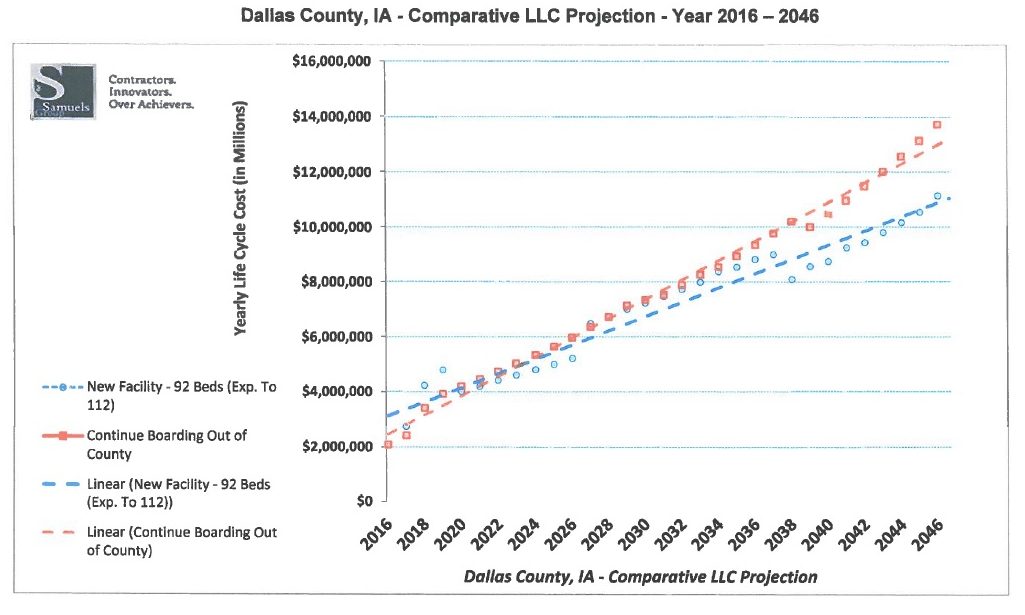
“Where the lines intersect is your break-even point,” Samuels said. “From the day when we start to see that red line escalate further up the chart versus the blue, that’s additional funds that we taxpayers are paying for Dallas inmates to be transported elsewhere. To me this is an important chart and an important demonstration as to why you want to consider constructing a new facility.”
In order to make their calculations, the Samuels Group used the basic design for the law enforcement facility as proposed in 2015 — minus Dallas County EMS and the Dallas County Emergency Operations Center, now housed at the Human Services campus north of Adel. They also calculated the future cost of doing nothing by projecting current operational costs and county population numbers 25 years forward.
At $21.3 million, the current design — a 92-bed facility, expandable to 172 beds — was planned for a 25-year life cycle, Samuels said.
Samuels said the project will make it necessary “to increase the size of the lagoons to handle the increased discharge.” Negotiations with the city of Adel to provide city sewer service are making progress, he said, but are unlikely to issue in a sewer connection in time for the opening of the new law enforcement center.
The recent history of Dallas County jail bond referendums shows repeated rejection of the bond sales by voters. In the first jail bond referendum, a special election held in August 2013, county voters decisively rejected a $16.8 million plan for a combination of public-safety facility and county administrative offices in the Ortonville area east of Adel.
Only 32 percent of voters approved the measure, far short of the 60 percent needed for passage of a bond referendum.
Some city leaders in Adel were particularly opposed to the 2013 project because it removed county offices from the vicinity courthouse square, a move they believed would be fatal to downtown retailers.
The Adel folks were happier when the supervisors returned in the general election of November 2014 with a $23.6 million plan that split the project in two, again placing the new law-enforcement center in Ortonville but with the new county offices now located on U.S. Highway 6 just west of the Raccoon River.
Once again, however, county voters said, “No,” rejecting both measures but giving the jail a 51 percent approval and the administrative offices 46 percent approval. The plan failed, but it seemed to “fail better.”
With the completed conversion of the former Dallas County Care Facility into administrative offices, the pressure for more room to house county workers was reduced, but the need for a larger jail was larger than ever. An August 2015 special election put the jail matter before the people in its third form — a $16.8 million plan for a stand-alone law enforcement center in Ortonville.
It was voted down, but the “Yes” vote was 53 percent, which some supervisors took as an encouraging sign that voters are slowly coming around to accepting the inevitable. With the planned 2017 ballot measure, the additional 18 months of doing nothing will cost taxpayers an additional $4.5 million.
The referendum language on the 2017 ballot will probably be along the lines of previous jail-bond referendums: “Shall the County of Dallas, State of Iowa, issue its general obligation bonds in an amount not exceeding the amount of $22,500,000 for the purpose of designing, constructing, erecting, equipping and furnishing a new sheriff’s office – law enforcement center, with related site improvements?”
The supervisors have contingency plans in the works for whichever way the voters decide. They accepted a $521,000 bid in early August from Johnston-based Brocon Services for the remodeling 902 Court St. Brocon’s was the lowest of eight general-contractor bids received for the work and came in well under the engineer’s original estimate of $630,000. The remodeled offices will permit a number of departments to occupy the former Community Services Department.
If voters in May approve selling the bonds to build a new law enforcement center, the old jail will possibly be used as a courtroom for the Fifth Judicial District. Purdy has presented the supervisors with preliminary plans for repurposing the jail at 901 Nile Kinnick Drive N. in anticipation of a yes vote.
The growth of the county’s population makes an additional district court judge and courtroom necessary, according to Iowa Code, and preliminary discussions with district court judges show them open to the idea of staging criminal court proceedings in the soon-to-be former jail.









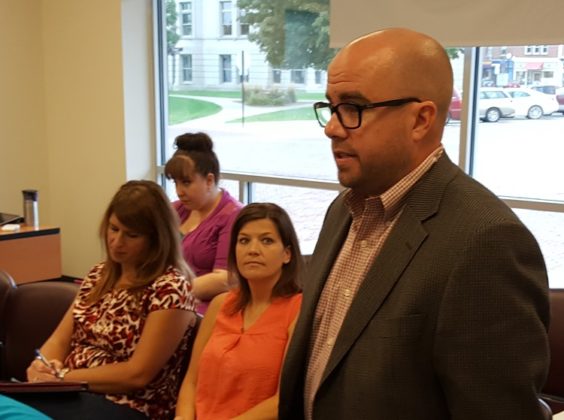
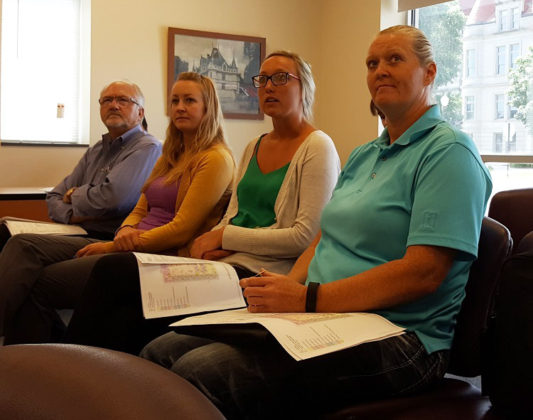
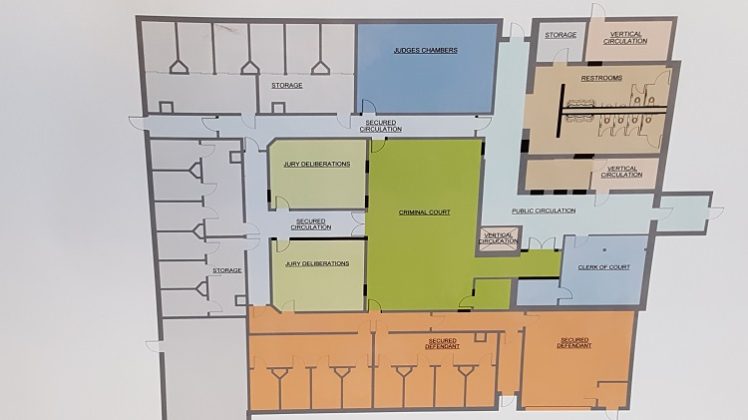

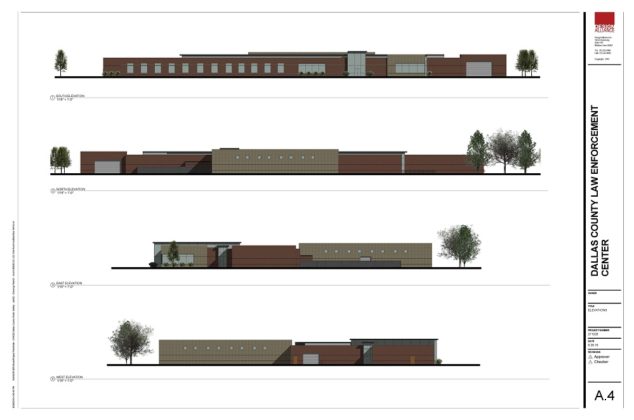

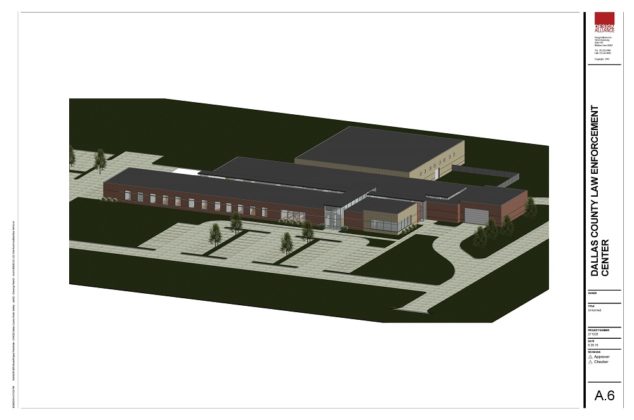








Why does this have to be paid for by property owners? Why can it not be tied to the State income tax like the schools are? Income tax would spread the load over more people.